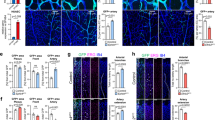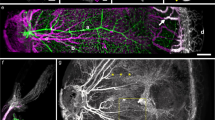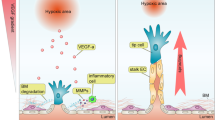Abstract
The retina is a powerful experimental system for the analysis of angiogenic blood vessel growth in the postnatal organisms. The three-dimensional architecture of the vessel network and processes as diverse as endothelial cell (EC) proliferation, sprouting, perivascular cell recruitment, vessel remodeling or maturation can be investigated at high resolution. The characterization of physiological and pathological angiogenic processes in mice has been greatly facilitated by inducible and cell type–specific loss-of-function and gain-of-function genetics. In this paper, we provide a detailed protocol for tamoxifen-inducible gene deletion in neonatal mice, as well as for retina dissection, whole-mount immunostaining and the quantitation of EC sprouting and proliferation. These methods have been optimized by our laboratory and yield reliable results. The entire protocol takes ~10 d to complete.
This is a preview of subscription content, access via your institution
Access options
Subscribe to this journal
Receive 12 print issues and online access
$259.00 per year
only $21.58 per issue
Buy this article
- Purchase on Springer Link
- Instant access to full article PDF
Prices may be subject to local taxes which are calculated during checkout






Similar content being viewed by others
References
Risau, W. & Flamme, I. Vasculogenesis. Annu. Rev. Cell Dev. Biol. 11, 73–91 (1995).
Adams, R.H. & Alitalo, K. Molecular regulation of angiogenesis and lymphangiogenesis. Nat. Rev. Mol. Cell Biol. 8, 464–478 (2007).
Staton, C.A., Reed, M.W. & Brown, N.J. A critical analysis of current in vitro and in vivo angiogenesis assays. Int. J. Exp. Pathol. 90, 195–221 (2009).
Glaser, B.M., D'Amore, P.A., Seppa, H., Seppa, S. & Schiffmann, E. Adult tissues contain chemoattractants for vascular endothelial cells. Nature 288, 483–484 (1980).
Alessandri, G., Raju, K. & Gullino, P.M. Mobilization of capillary endothelium in vitro induced by effectors of angiogenesis in vivo. Cancer Res. 43, 1790–1797 (1983).
Boyden, S. The chemotactic effect of mixtures of antibody and antigen on polymorphonuclear leucocytes. J. Exp. Med. 115, 453–466 (1962).
Wong, M.K. & Gotlieb, A.I. In vitro reendothelialization of a single-cell wound. Role of microfilament bundles in rapid lamellipodia-mediated wound closure. Lab. Invest. 51, 75–81 (1984).
Gospodarowicz, D., Moran, J., Braun, D. & Birdwell, C. Clonal growth of bovine vascular endothelial cells: fibroblast growth factor as a survival agent. Proc. Natl. Acad. Sci. USA 73, 4120–4124 (1976).
Kubota, Y., Kleinman, H.K., Martin, G.R. & Lawley, T.J. Role of laminin and basement membrane in the morphological differentiation of human endothelial cells into capillary-like structures. J. Cell Biol. 107, 1589–1598 (1988).
Lawley, T.J. & Kubota, Y. Induction of morphologic differentiation of endothelial cells in culture. J. Invest. Dermatol. 93, S59–S61 (1989).
Bayless, K.J., Kwak, H.I. & Su, S.C. Investigating endothelial invasion and sprouting behavior in three-dimensional collagen matrices. Nat. Protoc. 4, 1888–1898 (2009).
Nicosia, R.F. & Ottinetti, A. Modulation of microvascular growth and morphogenesis by reconstituted basement membrane gel in three-dimensional cultures of rat aorta: a comparative study of angiogenesis in matrigel, collagen, fibrin, and plasma clot. In Vitro Cell Dev. Biol. 26, 119–128 (1990).
Aplin, A.C., Fogel, E., Zorzi, P. & Nicosia, R.F. The aortic ring model of angiogenesis. Methods Enzymol. 443, 119–136 (2008).
Swaim, W.R. & Feders, M.B. Fibrinogen assay. Clin. Chem. 13, 1026–1028 (1967).
Chalupowicz, D.G., Chowdhury, Z.A., Bach, T.L., Barsigian, C. & Martinez, J. Fibrin II induces endothelial cell capillary tube formation. J. Cell Biol. 130, 207–215 (1995).
Bayless, K.J. & Davis, G.E. Sphingosine-1-phosphate markedly induces matrix metalloproteinase and integrin-dependent human endothelial cell invasion and lumen formation in three-dimensional collagen and fibrin matrices. Biochem. Biophys. Res. Commun. 312, 903–913 (2003).
Koh, W., Stratman, A.N., Sacharidou, A. & Davis, G.E. In vitro three dimensional collagen matrix models of endothelial lumen formation during vasculogenesis and angiogenesis. Methods Enzymol. 443, 83–101 (2008).
Stratman, A.N. et al. Endothelial cell lumen and vascular guidance tunnel formation requires MT1-MMP-dependent proteolysis in 3-dimensional collagen matrices. Blood 114, 237–247 (2009).
Gimbrone, M.A. Jr. Cotran, R.S., Leapman, S.B. & Folkman, J. Tumor growth and neovascularization: an experimental model using the rabbit cornea. J. Natl. Cancer Inst. 52, 413–427 (1974).
Fournier, G.A., Lutty, G.A., Watt, S., Fenselau, A. & Patz, A. A corneal micropocket assay for angiogenesis in the rat eye. Invest. Ophthalmol. Vis. Sci. 21, 351–354 (1981).
Auerbach, R., Kubai, L., Knighton, D. & Folkman, J. A simple procedure for the long-term cultivation of chicken embryos. Dev. Biol. 41, 391–394 (1974).
Ribatti, D., Vacca, A., Roncali, L. & Dammacco, F. The chick embryo chorioallantoic membrane as a model for in vivo research on angiogenesis. Int. J. Dev. Biol. 40, 1189–1197 (1996).
Dohle, D.S. et al. Chick ex ovo culture and ex ovo CAM assay: how it really works. J. Vis. Exp. doi:10.3791/1620 (2009).
Alajati, A. et al. Spheroid-based engineering of a human vasculature in mice. Nat. Methods 5, 439–445 (2008).
Laib, A.M. et al. Spheroid-based human endothelial cell microvessel formation in vivo. Nat. Protoc. 4, 1202–1215 (2009).
Martin, P. Wound healing—aiming for perfect skin regeneration. Science 276, 75–81 (1997).
Eming, S.A., Brachvogel, B., Odorisio, T. & Koch, M. Regulation of angiogenesis: wound healing as a model. Prog. Histochem. Cytochem. 42, 115–170 (2007).
Papenfuss, H.D., Gross, J.F., Intaglietta, M. & Treese, F.A. A transparent access chamber for the rat dorsal skin fold. Microvasc. Res. 18, 311–318 (1979).
Vajkoczy, P. et al. Inhibition of tumor growth, angiogenesis, and microcirculation by the novel Flk-1 inhibitor SU5416 as assessed by intravital multi-fluorescence videomicroscopy. Neoplasia 1, 31–41 (1999).
Endrich, B., Asaishi, K., Gotz, A. & Messmer, K. Technical report—a new chamber technique for microvascular studies in unanesthetized hamsters. Res. Exp. Med. (Berl.) 177, 125–134 (1980).
Swift, M.R. & Weinstein, B.M. Arterial-venous specification during development. Circ. Res. 104, 576–588 (2009).
Gariano, R.F. & Gardner, T.W. Retinal angiogenesis in development and disease. Nature 438, 960–966 (2005).
Fukumura, D. & Jain, R.K. Tumor microvasculature and microenvironment: targets for anti-angiogenesis and normalization. Microvasc. Res. 74, 72–84 (2007).
Kerbel, R.S. Tumor angiogenesis: past, present and the near future. Carcinogenesis 21, 505–515 (2000).
Carmeliet, P. & Collen, D. Transgenic mouse models in angiogenesis and cardiovascular disease. J. Pathol. 190, 387–405 (2000).
Naumov, G.N., Akslen, L.A. & Folkman, J. Role of angiogenesis in human tumor dormancy: animal models of the angiogenic switch. Cell Cycle 5, 1779–1787 (2006).
Rocha, S.F. & Adams, R.H. Molecular differentiation and specialization of vascular beds. Angiogenesis 12, 139–147 (2009).
Connor, K.M. et al. Quantification of oxygen-induced retinopathy in the mouse: a model of vessel loss, vessel regrowth and pathological angiogenesis. Nat. Protoc. 4, 1565–1573 (2009).
Benedito, R. et al. The notch ligands Dll4 and Jagged1 have opposing effects on angiogenesis. Cell 137, 1124–1135 (2009).
Wang, Y. et al. Ephrin-B2 controls VEGF-induced angiogenesis and lymphangiogenesis. Nature 465, 483–486 (2010).
Branda, C.S. & Dymecki, S.M. Talking about a revolution: the impact of site-specific recombinases on genetic analyses in mice. Dev. Cell 6, 7–28 (2004).
Sauer, B. & Henderson, N. Site-specific DNA recombination in mammalian cells by the Cre recombinase of bacteriophage P1. Proc. Natl. Acad. Sci. USA 85, 5166–5170 (1988).
Sauer, B. & Henderson, N. Targeted insertion of exogenous DNA into the eukaryotic genome by the Cre recombinase. New Biol. 2, 441–449 (1990).
Feil, R. et al. Ligand-activated site-specific recombination in mice. Proc. Natl. Acad. Sci. USA 93, 10887–10890 (1996).
Indra, A.K. et al. Temporally-controlled site-specific mutagenesis in the basal layer of the epidermis: comparison of the recombinase activity of the tamoxifen-inducible Cre-ER(T) and Cre-ER(T2) recombinases. Nucleic Acids Res. 27, 4324–4327 (1999).
Claxton, S. et al. Efficient, inducible Cre-recombinase activation in vascular endothelium. Genesis 46, 74–80 (2008).
Sawamiphak, S. et al. Ephrin-B2 regulates VEGFR2 function in developmental and tumour angiogenesis. Nature 465, 487–491 (2010).
Gerhardt, H. & Betsholtz, C. High-resolution in situ confocal analysis of endothelial cells. in Methods in Endothelial Cell Biology (ed. Augustin, H.G.) 313–323 (Springer-Verlag, 2004).
Aguilar, E. et al. Chapter 6. Ocular models of angiogenesis. Methods Enzymol. 444, 115–158 (2008).
Gerhardt, H. et al. VEGF guides angiogenic sprouting utilizing endothelial tip cell filopodia. J. Cell Biol. 161, 1163–1177 (2003).
Fruttiger, M. et al. PDGF mediates a neuron-astrocyte interaction in the developing retina. Neuron 17, 1117–1131 (1996).
Lobov, I.B. et al. Delta-like ligand 4 (Dll4) is induced by VEGF as a negative regulator of angiogenic sprouting. Proc. Natl. Acad. Sci. USA 104, 3219–3224 (2007).
Laitinen, L. Griffonia simplicifolia lectins bind specifically to endothelial cells and some epithelial cells in mouse tissues. Histochem. J. 19, 225–234 (1987).
Laitinen, L., Virtanen, I. & Saxen, L. Changes in the glycosylation pattern during embryonic development of mouse kidney as revealed with lectin conjugates. J. Histochem. Cytochem. 35, 55–65 (1987).
Alroy, J., Goyal, V. & Warren, C.D. Lectin histochemistry of gangliosidosis. I. Neural tissue in four mammalian species. Acta. Neuropathol. 76, 109–114 (1988).
Grunwald, I.C. et al. Hippocampal plasticity requires postsynaptic ephrinBs. Nat. Neurosci. 7, 33–40 (2004).
Srinivas, S. et al. Cre reporter strains produced by targeted insertion of EYFP and ECFP into the ROSA26 locus. BMC Dev. Biol. 1, 4 (2001).
Wang, H.U., Chen, Z.F. & Anderson, D.J. Molecular distinction and angiogenic interaction between embryonic arteries and veins revealed by ephrin-B2 and its receptor Eph-B4. Cell 93, 741–753 (1998).
Baluk, P., Morikawa, S., Haskell, A., Mancuso, M. & McDonald, D.M. Abnormalities of basement membrane on blood vessels and endothelial sprouts in tumors. Am. J. Pathol. 163, 1801–1815 (2003).
Acknowledgements
We thank S.F. Rocha for her help, A. Eichmann for sharing unpublished data, S. Volkery for microscopy and M.L. Bocheneck for reading the paper. The Max Planck Society and the University of Münster have provided support and funding for this research.
Author information
Authors and Affiliations
Contributions
M.E.P. and R.H.A. designed the experiments; M.E.P. and I.S. carried out the experiments; M.E.P., R.B. and R.H.A. contributed to the development of the methods and wrote the paper.
Corresponding author
Ethics declarations
Competing interests
The authors declare no competing financial interests.
Supplementary information
Supplementary Video 1
Intragastric injection of tamoxifen in a one–day–old mouse. (MOV 6883 kb)
Supplementary Video 2
Retina dissection. (MOV 9397 kb)
Supplementary Video 3
Retina dissection. (MOV 5141 kb)
Rights and permissions
About this article
Cite this article
Pitulescu, M., Schmidt, I., Benedito, R. et al. Inducible gene targeting in the neonatal vasculature and analysis of retinal angiogenesis in mice. Nat Protoc 5, 1518–1534 (2010). https://doi.org/10.1038/nprot.2010.113
Published:
Issue Date:
DOI: https://doi.org/10.1038/nprot.2010.113
This article is cited by
-
PIEZO1 and PECAM1 interact at cell-cell junctions and partner in endothelial force sensing
Communications Biology (2023)
-
Retinoids stored locally in the lung are required to attenuate the severity of acute lung injury in male mice
Nature Communications (2023)
-
Astroglial Hmgb1 regulates postnatal astrocyte morphogenesis and cerebrovascular maturation
Nature Communications (2023)
-
MEK inhibition reduced vascular tumor growth and coagulopathy in a mouse model with hyperactive GNAQ
Nature Communications (2023)
-
The VE-cadherin/AmotL2 mechanosensory pathway suppresses aortic inflammation and the formation of abdominal aortic aneurysms
Nature Cardiovascular Research (2023)
Comments
By submitting a comment you agree to abide by our Terms and Community Guidelines. If you find something abusive or that does not comply with our terms or guidelines please flag it as inappropriate.



